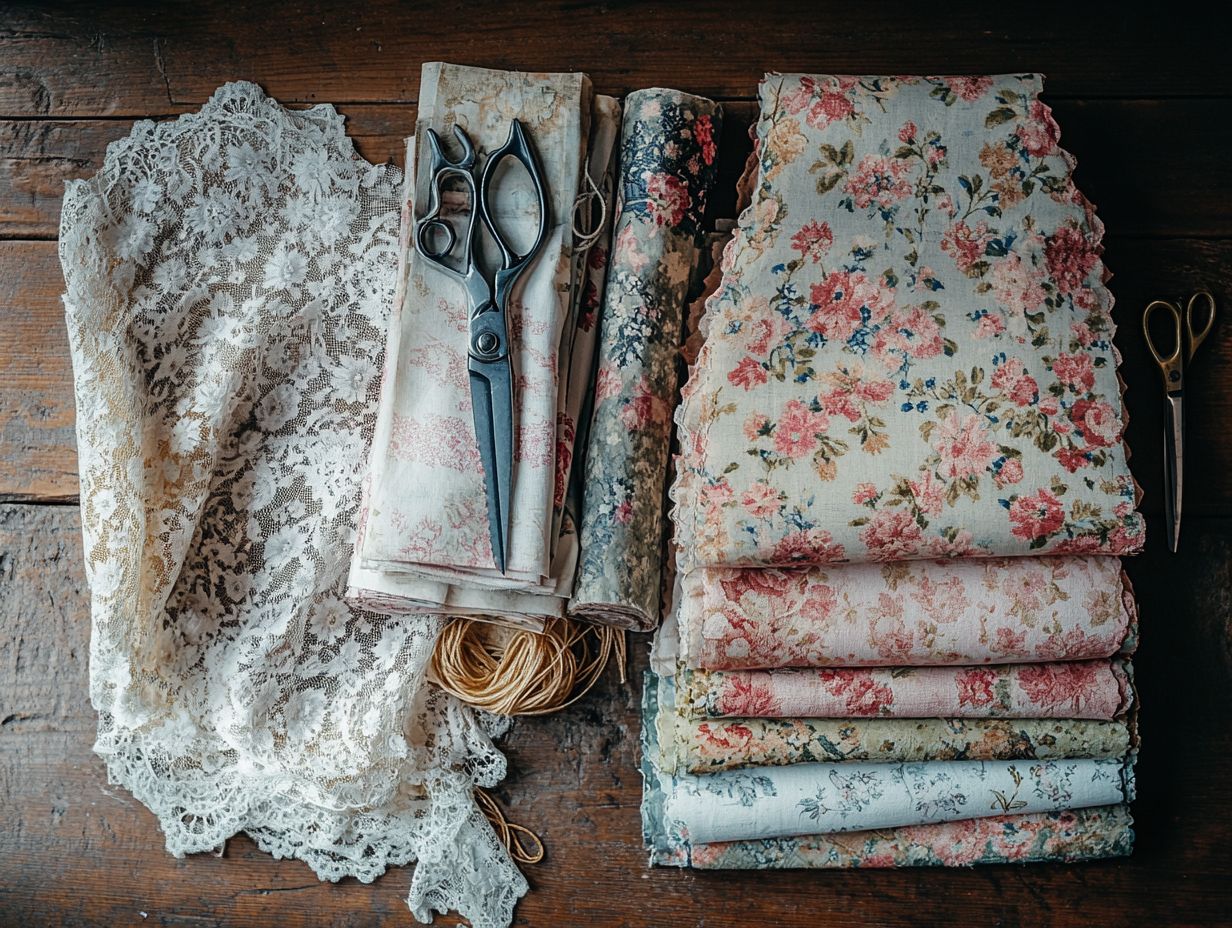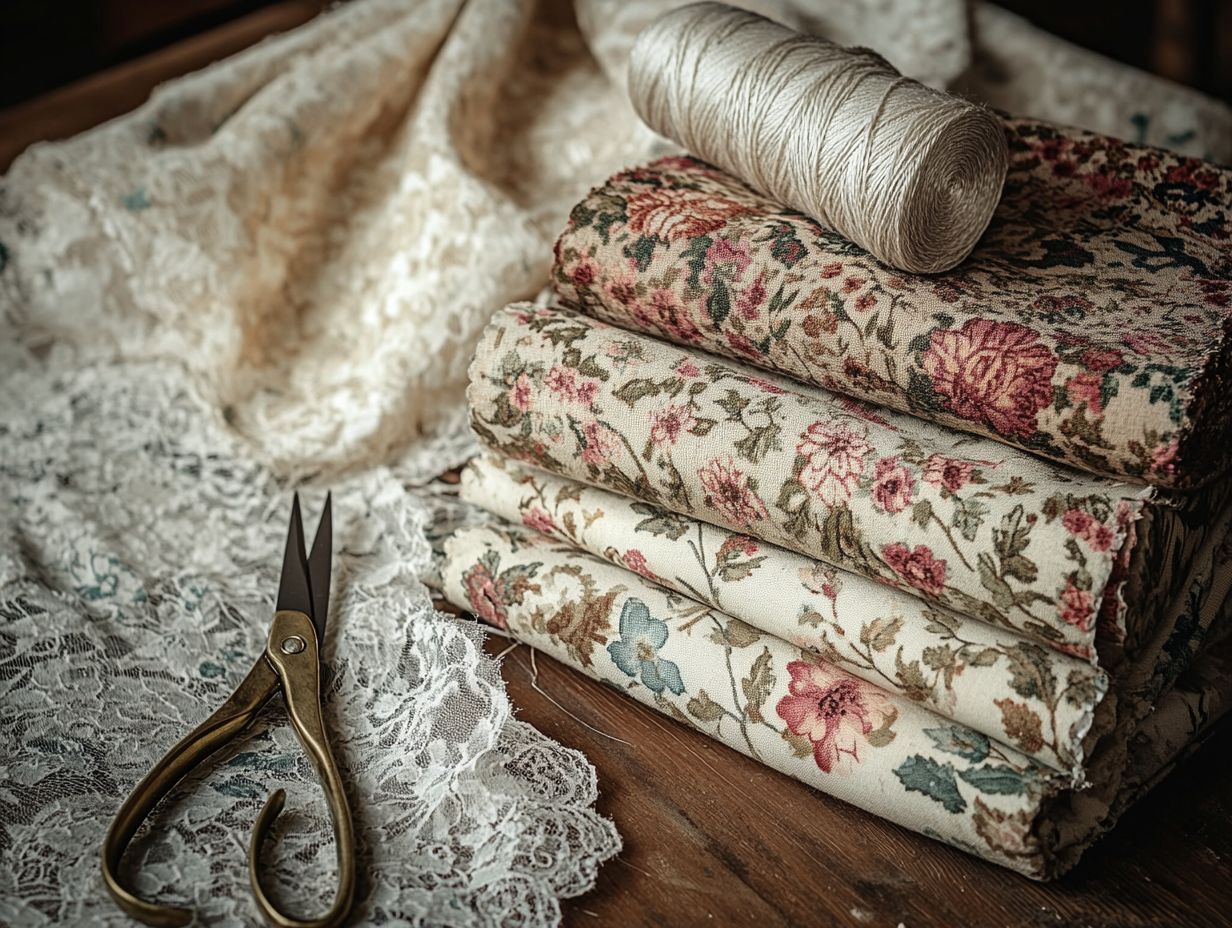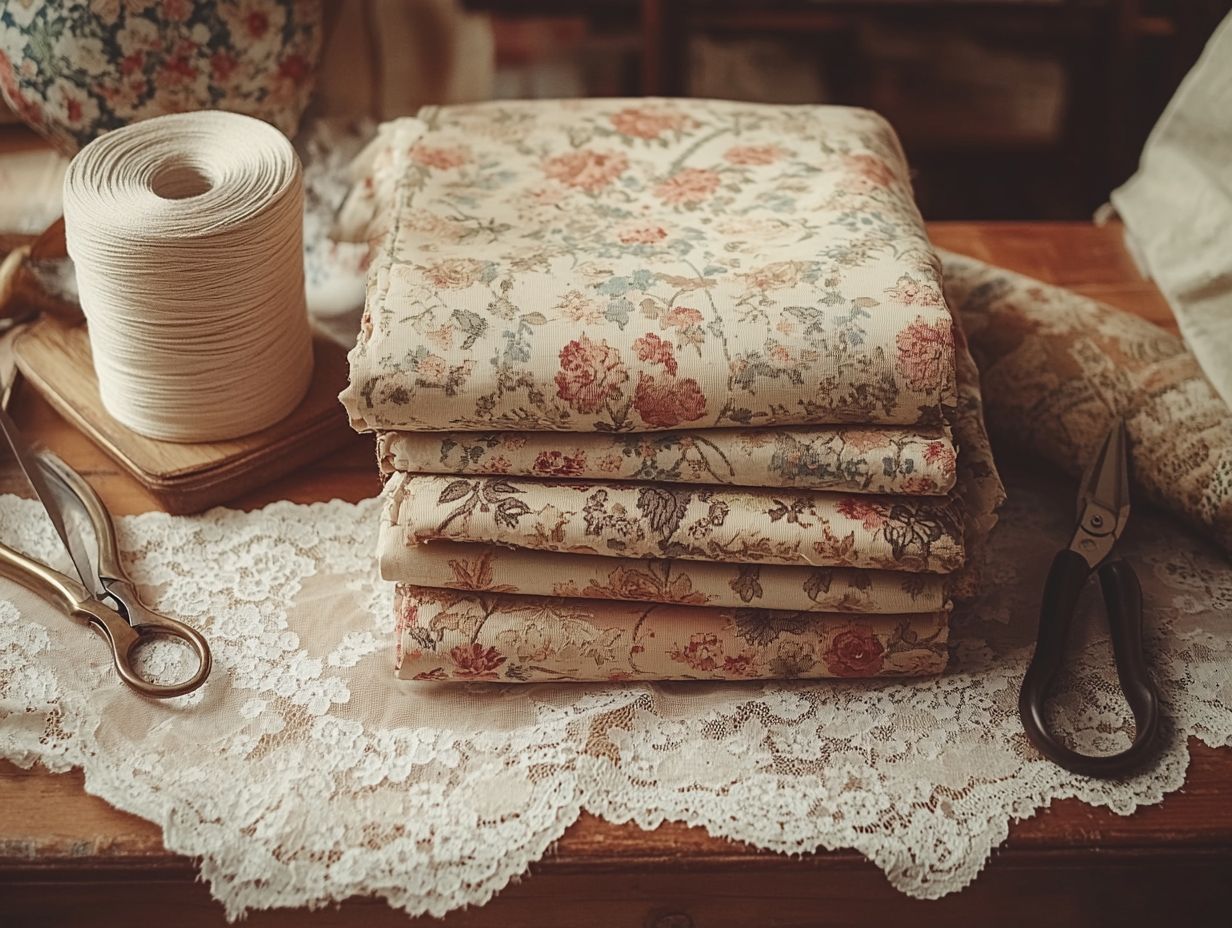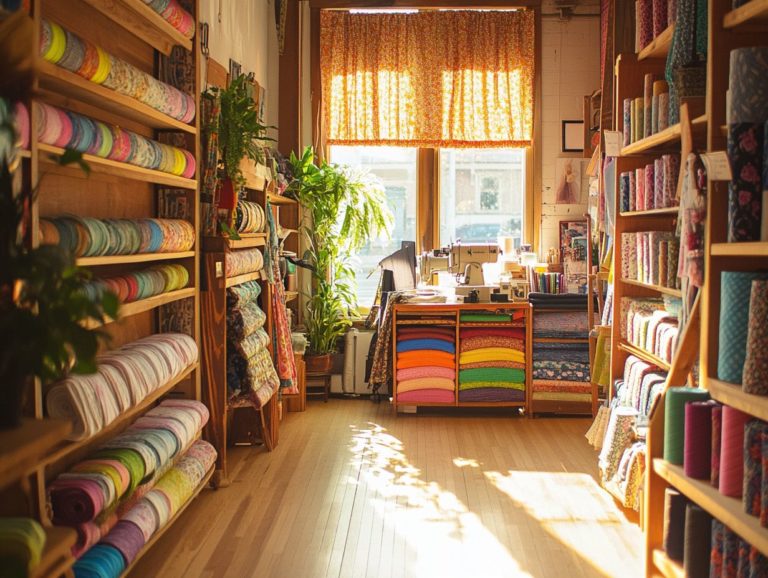5 Vintage Fabric Care Tips for Beginners
Caring for vintage fabrics may seem like an overwhelming challenge, especially if you re just starting out. However, with the right knowledge and techniques, you can preserve their beauty and extend their life for many years to come.
This article provides essential tips for identifying various vintage fabrics, understanding care labels, and employing appropriate washing methods for cleaning, stain removal techniques, and best practices for storing and restoring these cherished items.
Get ready to pamper your vintage treasures with the care they absolutely deserve.
Contents
Key Takeaways:

- Understand the various types of vintage fabrics to properly care for them and prevent damage.
- Always check the care labels on vintage fabrics before cleaning to ensure the proper washing and drying method is used.
- Hand-washing or using a gentle wash cycle with mild detergents will help preserve the delicate nature of vintage fabrics, especially wool and silk.
1. Understand the Different Types of Vintage Fabrics and Synthetic Fibers
Understanding the various types of vintage fabrics is essential for anyone who truly appreciates vintage clothing. Each fabric possesses unique properties that dictate how it should be cared for, cleaned, and maintained to ensure its longevity and pristine condition. Vintage fabrics like wool, silk, cotton, and synthetics such as polyester each require specific cleaning techniques to prevent damage and preserve their timeless allure.
Wool, renowned for its warmth and durability, benefits from gentle hand washing or dry cleaning to maintain its texture. Silk, on the other hand, is exceptionally delicate and often requires cold water washing or professional cleaning to prevent fading and the weakening of its fibers.
Cotton is generally more forgiving and can typically be machine washed. However, be cautious to avoid shrinkage.
As for synthetics, polyester fabrics are durable and often wrinkle-resistant, needing much less intricate care.
By grasping these characteristics, vintage enthusiasts can engage with their collections thoughtfully, ensuring that each piece retains its charm for years to come.
2. Always Read the Care Labels
Reading care labels on vintage clothing is absolutely essential. These labels tell you how to clean the fabric without damaging it.
Think of these labels as your personal guide, offering insights into fabric content and tailored processing recommendations for various materials. For example, while cotton can handle a spin in the washing machine, delicate silks and wool demand a gentler touch hand washing or dry cleaning is the way to go to avoid irreversible damage.
Grasping these distinctions not only ensures your garments retain their aesthetic charm but also prolongs their lifespan. This allows you to cherish these unique pieces for years to come. By preventing mishaps like fading, shrinking, or improper handling, you safeguard the rich history woven into every vintage fabric.
3. Hand-Wash or Use a Gentle Cycle
When you re cleaning vintage clothing, choosing between a hand wash or a gentle cycle is often your best bet for preserving those delicate fabrics and avoiding any damage during the process.
Hand washing is particularly advantageous; it offers a controlled environment where you can use cool water and mild detergents, significantly reducing the risk of color bleeding and fabric wear. This method allows for gentle agitation, effectively lifting dirt and stains without causing any fraying or fading.
If you’re short on time, a gentle cycle is quick, but always check fabric settings first. Before diving into any washing method, remember to conduct a fabric test on a hidden area. This step ensures that your chosen cleaning technique and product are compatible with the vintage material, safeguarding the integrity of your cherished garments. Additionally, be aware of common mistakes when working with vintage fabrics to further protect your items.
4. Use Mild Detergents and Avoid Bleach

When cleaning vintage fabrics, use mild detergents like Eucalan or Oxiclean. Avoid bleach at all costs; harsh chemicals can damage the fibers and colors of these delicate materials.
Gentle cleansers preserve your cherished garments and keep them vibrant. Eucalan’s no-rinse formula cleans without stripping natural oils, which is perfect for delicate laces and silks.
Oxiclean, when properly diluted, tackles tough stains safely. If you face specific stains like wine or ink, apply a mild detergent directly and gently work it into the fabric. Always test on an inconspicuous spot first.
5. Air Dry or Use Low Heat
To prolong the life of your vintage fabrics, air dry them or use low heat settings when drying. These gentle methods reduce the risk of shrinkage and damage.
They help maintain the original shape and fit of your beloved garments. High temperatures can degrade natural fibers like silk, wool, and cotton, leading to problems like fraying.
Air drying allows moisture to evaporate slowly. This is important for preserving the intricate details often found in vintage pieces.
What Are the Benefits of Caring for Vintage Fabrics?
Caring for vintage fabrics offers numerous benefits. You can prolong their life and preserve their beauty.
When treated with care, vintage textiles retain their vibrant colors and intricate details, standing out in any collection. This commitment also ensures these items can be enjoyed by future generations.
Preventative measures like keeping them out of direct sunlight and using breathable storage materials protect delicate fibers. Addressing spills and odors quickly prevents minor issues from becoming major problems.
By practicing responsible maintenance, you help sustain the legacy of these artistic treasures for future generations.
What Are Common Mistakes People Make When Caring for Vintage Fabrics?
Common mistakes often arise from misunderstanding the specific needs of various materials. Improper cleaning methods and neglecting fabric testing can lead to damage.
One frequent error is using harsh detergents, which can strip delicate fibers. People often overlook care labels, mistakenly assuming all vintage textiles can be treated the same way.
Skipping the fabric test is another pitfall. Always test a small, inconspicuous area before applying any cleaning solution to prevent disaster!
To avoid these issues, research the specific fabrics in your collection. Following recommended cleaning practices, such as the best vintage fabric restoration techniques, ensures each piece retains its timeless beauty.
How Can You Remove Stains from Vintage Fabrics?

Removing stains from vintage fabrics demands a careful touch that honors the delicate nature of these materials while effectively using appropriate cleaning techniques and stain removal products.
It’s crucial to know that each fabric type be it silk, velvet, or linen has its unique vulnerabilities, requiring customized solutions. Before you start the stain removal journey, always conduct a patch test in an inconspicuous area to see if your method is safe for the fabric.
For instance, when tackling silk, opt for a gentle detergent designed for delicate fabrics. A simple mixture of mild soap and water works wonders for cotton blends. Vintage fabrics often respond beautifully to natural methods, like vinegar or baking soda, offering an effective yet gentle approach. If you’re interested in incorporating these unique materials, check out the 5 vintage fabric trends making a comeback.
By keeping these insights in mind, you can achieve the best results while using safe products and techniques without sacrificing the integrity of your cherished garments.
What Are the Best Practices for Storing Vintage Fabrics?
Storing vintage fabrics and clothes with the right practices is essential for preventing deterioration and ensuring that each piece retains its charm and integrity over time.
To achieve this, invest in breathable garment bags made from cotton or muslin. These materials allow for air circulation while keeping dust and pests at bay. It s important to observe proper storage conditions; steering clear of direct sunlight is crucial, as UV rays can fade colors and weaken fibers over time. Maintaining a stable environment with consistent temperature and humidity levels is key to preventing mold growth and fabric discoloration.
Don t wait! Regularly inspect your treasured items to avoid irreversible damage, and ensure they are clean before storage to significantly enhance their lifespan. Preventive care is the cornerstone of long-term preservation.
How Can You Restore Vintage Fabrics?
Restoring vintage fabrics is an art that demands a refined understanding of various fabric types, vintage cleaning methods, and the right restoration techniques to reclaim their original beauty without inflicting further damage.
A meticulous approach is essential to preserve the integrity of these cherished materials. Your first task is to assess the fabric’s condition, closely examining it for stains, discoloration, or structural weaknesses.
Each type of fabric, be it silk, cotton, or wool, requires its own specific cleaning process; for example, silk may need a gentle hand wash, while more robust fabrics like cotton can handle machine washing without a hitch. Additionally, consider exploring 5 ways to use vintage fabrics in craft projects to creatively repurpose your materials.
Repair methods also vary significantly; patching may be ideal for tougher fabrics, whereas delicate textiles often benefit from invisible stitching to maintain their pristine appearance. Considering factors like age and any previous repairs will guide your choice of techniques, ensuring that your restoration honors the fabric’s rich history.
What Are Some Tips for Handling and Wearing Vintage Fabrics?
Handling and wearing vintage fabrics calls for a touch of finesse to ensure these unique pieces retain their charm and longevity. It s essential to grasp the proper care tips and techniques to truly enjoy your vintage treasures.
To fully appreciate the allure of vintage clothing, focus on a few key practices. Start by always handling these delicate materials with clean hands; this simple step helps prevent the transfer of oils or dirt that could tarnish their beauty. Regarding fit, consider opting for tailored alterations instead of forcing a piece to mold to your body shape; this can significantly enhance both comfort and style. Additionally, learning how to care for vintage textiles and fabrics will help maintain their charm for years to come.
Caring for vintage garments often means hand washing in cold water with gentle detergents to preserve the fabric’s integrity. For those looking to maintain these items, learning how to repair vintage fabrics at home can be invaluable. Air drying is the way to go, protecting against shrinkage or color fading, ensuring these cherished pieces remain a source of enjoyment for years to come.
Frequently Asked Questions

What are some important tips for caring for vintage fabrics as a beginner?
1. Always read the care label before washing or drying a vintage fabric. This ensures you are using the correct methods for that specific fabric.
2. Avoid using harsh chemicals or bleach on vintage fabrics. They can damage delicate fibers and cause discoloration.
3. When storing vintage fabrics, make sure they are clean and completely dry. Moisture can lead to mold and mildew, causing irreparable damage.
4. Use gentle detergent and hand wash vintage fabrics whenever possible. This helps preserve the fabric’s original color and texture.
5. If you must use a washing machine, select the delicate or hand-wash cycle. Place the fabric in a mesh bag to protect it from agitators or rough edges.
What should I do if my vintage fabric gets stained?
If your vintage fabric gets stained, treat the stain immediately. Blot the stain with a clean, damp cloth and avoid rubbing to prevent spreading. If the stain doesn’t come out, take it to a dry cleaner who knows vintage fabrics.
Is it safe to use a dryer for vintage fabrics?
Avoid using a dryer. The high heat can shrink or damage delicate fabrics. Instead, lay the fabric flat to air dry or hang it on a clothesline in a shaded area.
Can I iron vintage fabrics?
It is best to avoid using an iron on vintage fabrics, as the heat can cause damage.
If wrinkles appear, use a steamer or place a damp cloth over the fabric and press lightly with a warm iron.
How can I prevent moth damage to my vintage fabrics?
To prevent moth damage, store your vintage fabrics in airtight containers or garment bags. Add lavender sachets or cedar blocks to help repel moths. Regularly check on your stored fabrics to ensure there are no signs of moth infestation.






